A historical tour of Baodingshan Cliff Stone Carving

On the afternoon of November 28, 2020, I went to the cliff stone carvings on Baoding Mountain in Dazu.

Baoding Mountain is 527.83 meters above sea level. The area of cliff statues in Baoding Mountain seems to be the largest among the five Dazu stone carvings.
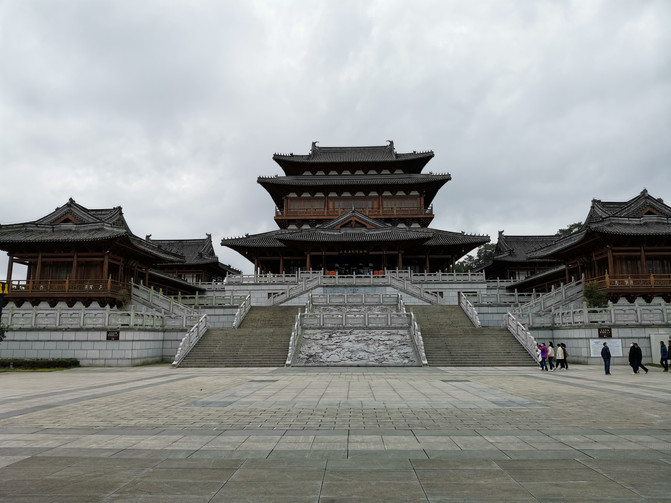
First, we went to the Dazu Stone Carving Museum to get a general understanding of the history of grotto art in the world and China and the basic context of Dazu stone carvings. After that, we went to the Baodingshan Stone Carving Big Buddha Bay area for a tour.


The Baodingshan stone carving was carved by Zhao Zhifeng, an eminent monk of the Song Dynasty, from the sixth year of Chunxi to the ninth year of Chunyou in the Southern Song Dynasty (1179 - 1249). It took more than 70 years to dig it out. It is a complete and unique large-scale Buddhist tantric temple with more than 10,000 statues and is rare among grottoes.


With Shengshou Temple as the center, it is divided into two areas: Dafo Bay and Xiaofo Bay, of which Dafo Bay is the main body. Different from the Beishan stone carvings, the theme of the Baodingshan stone carvings has obvious characteristics of Buddhist secularization, and conveys simple teachings with a popular and intuitive storyline.


Dafo Bay is a deep horseshoe-shaped mountain bay with a cliff surface of about 500 meters long and a height of about 8-25 meters. Carved statues are distributed on the cliffs on the east, south and north sides. It consists of 19 groups of Buddhist scriptures stories. Various statues have more than 15000 bodies. All statues have pictures and texts. The design is exquisite, and there is no niche that is identical and repeated, breaking the saying of "a thousand Buddhas one face". There are both doctrinal intrinsic connections and formal connections between niches and grottoes, forming an organic whole. In turn, the statue of Dharma Protector, the Six Paths of Reincarnation, the Vast Treasure Pavilion, the Three Saints of Hua Yan, the Thousand Hand Guanyin, the Story of Buddha, the Holy Land of Sakyamuni, the Nine Dragons Bathing Prince, the Peacock Mingwang Sutra in disguise, the Pilu Cave, the Parental Grace Sutra in disguise, the Thunderclap Diagram, the Great Convenience Buddha Revening Grace Sutra in disguise, the Buddhist Sutra in disguise, the Six Consumption Diagram in disguise, the Buddha in disguise, the Liu Den Xing Tu, the Ten Great Bright Kings, the Cattle Shepherd Tu, the Yuanjue Cave, the Liu Den Zhengjue statue, etc.


In this area in front of you is a prominent place where the Tang Yoga Sect Master holds a painting of Wang Liu's true body. The scene is magnificent.





This area is a disguised shrine in the underworld, showing the scene of the ferocious and powerful ox head and horse face in the 18th floor of hell, and the victims shouting to the sky and the earth. Torture such as sharp knife, sawing, frying pan, ice, and boiling soup is appalling and shocking.







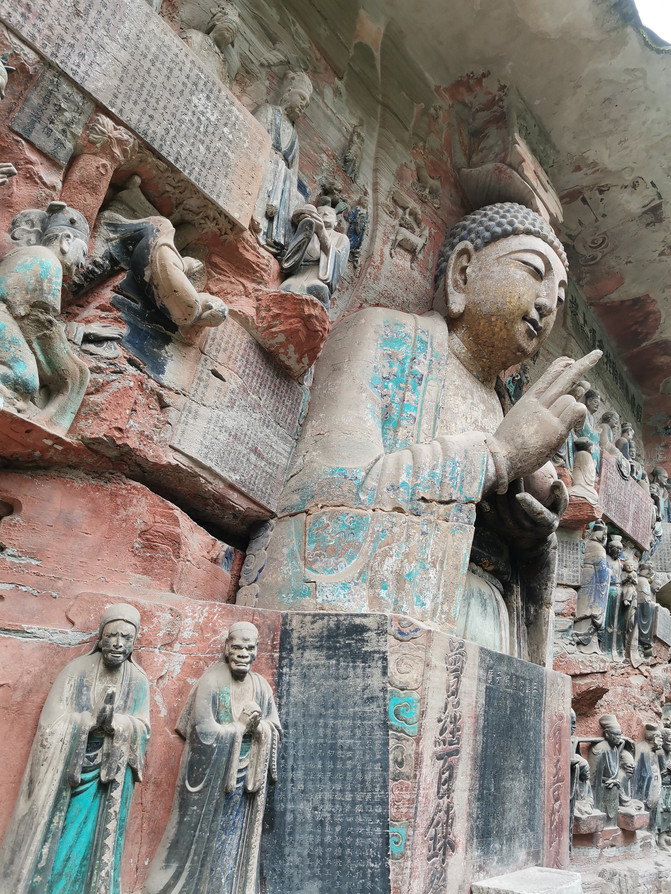






Stone carvings such as the Parental Grace Sutra in disguise, the Thunderclap Diagram, the Great Convenience Buddha Revenge Sutra in disguise, the Buddhist Sutra in disguise, and the Peacock Mingwang Sutra in disguise declare exhortations. Both Buddha statues and animal shapes are lifelike.


The statue of the Sakya Nirvana Holy Land Map is unique. Ancient craftsmen adopted a deliberate brushwork method. The reclining Buddha is 31 meters long and only half of its body is visible, to show that the Buddha is immeasurable. Shakya lay on his right side, his eyes slightly closed, and his expression was calm and peaceful.
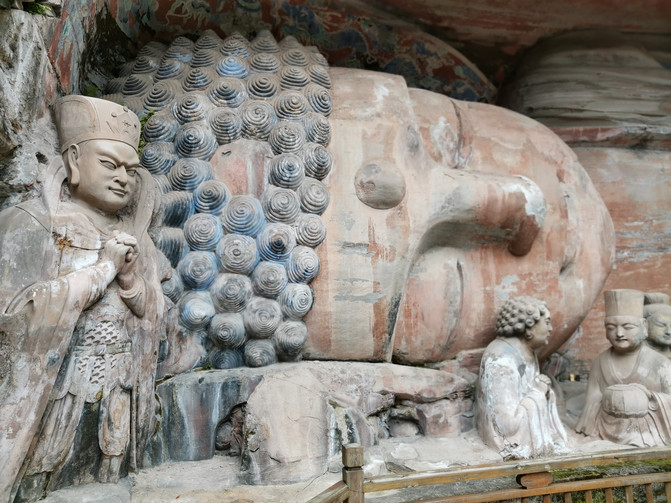

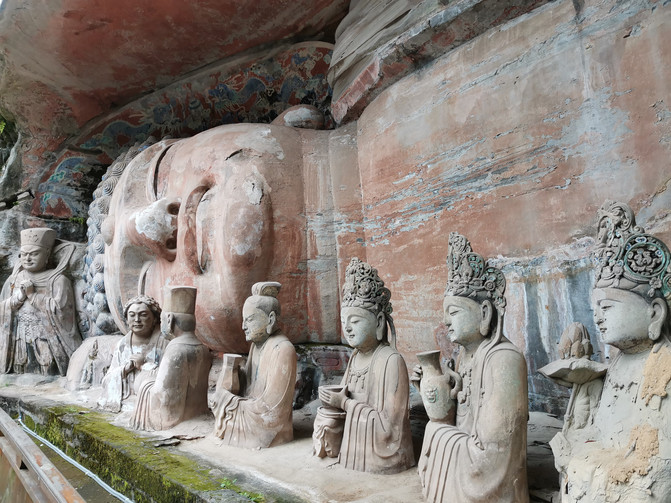
The 18 portraits of disciples carved in front of him are also busts, some standing with their palms closed, some holding fragrant flowers and fruits, some holding Ruyi, or some looking sideways. They are all calm and solemn, showing the disciples 'reverence, love and affection for the deceased. Love. The statue of the entire niche is grand and has profound artistic conception. It is not only in line with religious rituals, but also unique, and is rare in Chinese grotto art.

The stone carving of the Jiulong Bathing Prince next to the statue of the Sakyamuni Nirvana Shrine shows that the ancients combined the Buddhist story of the Jiulong Empowerment with the unique geographical environment of Baoding Mountain to draw rainwater and spring water from the cliff from the giant dragon in the carved Jiulong Zhongzheng. Out of the mouth, a trickle of clear water flows to the carved stone statue of the Prince Sakyamuni below. The Crown Prince put his hands together with a calm expression. The half of his body appeared on the rectangular stage. At each end of the stage, there was a heavenly king with a helmet and armor. The heavenly king on the left pointed to the sky and the heavenly king on the right pointed to the earth, implying the will of Prince Sakya's self-proclaimed "heaven and earth, I am supreme."

The Thousand-Hand Guanyin statue on the cliff carved in the middle and late Southern Song Dynasty has a history of more than 800 years. The statue niche is 7.7 meters high and 12.5 meters wide. The ancients used a crisscross layout, overlapping top and bottom, and supporting each other on the opposite sides, deeply involved in the scattered layout. 830 hands and eyes are engraved on the 88-square-meter cliff surface. It integrates sculpture, color painting, and gold pasting into one, and looks like a peacock opening its screen. It is known as the "wonder of the world" and "the unique in the world."
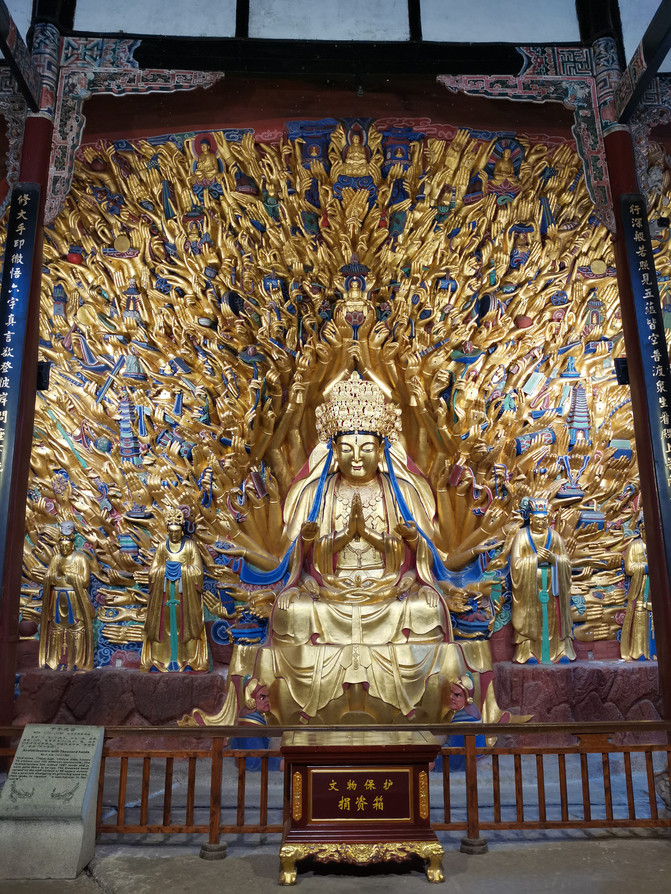

This statue of the thousand-handed Guanyin has been eroded by various "diseases" such as weathering. It has been restored many times in history. In recent years, the statue of Guanyin has been restored, recreating its splendid atmosphere

The Three Saints Statues of Huayan are the three exquisite stone carvings among the Baodingshan stone carvings. In the middle is the Piluzhana Buddha, on the left is the Manjusri Bodhisattva who is the ruler of wisdom, and on the right is the Samantabhadra Bodhisattva who is the ruler of virtue.
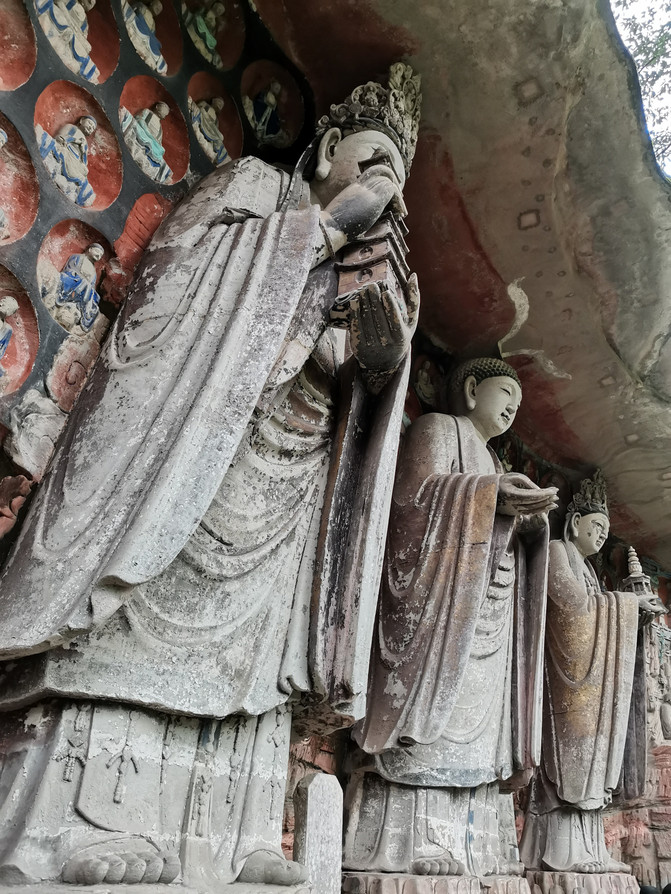


Manjusri Bodhisattva holds the seven-story pagoda in his left hand and holds it with his right hand. It is said that the seven-story pagoda in Manjusri's hand is 1.8 meters high and weighs 800 kilograms. Why is the pagoda so heavy but not falling for hundreds of years? The reason is that they make full use of the principles of mechanics and support the left-handed tower through the cassock. The ingenuity of the ancients is amazing.


The stone carvings of the Six Paths of Reincarnation show the world that good and evil reward interest, all in the mind of the people. If you can become good, you will rise to the realm of heaven and man, and if you start thinking evil, you will fall into the path of evil, and the cause and effect will be obvious.


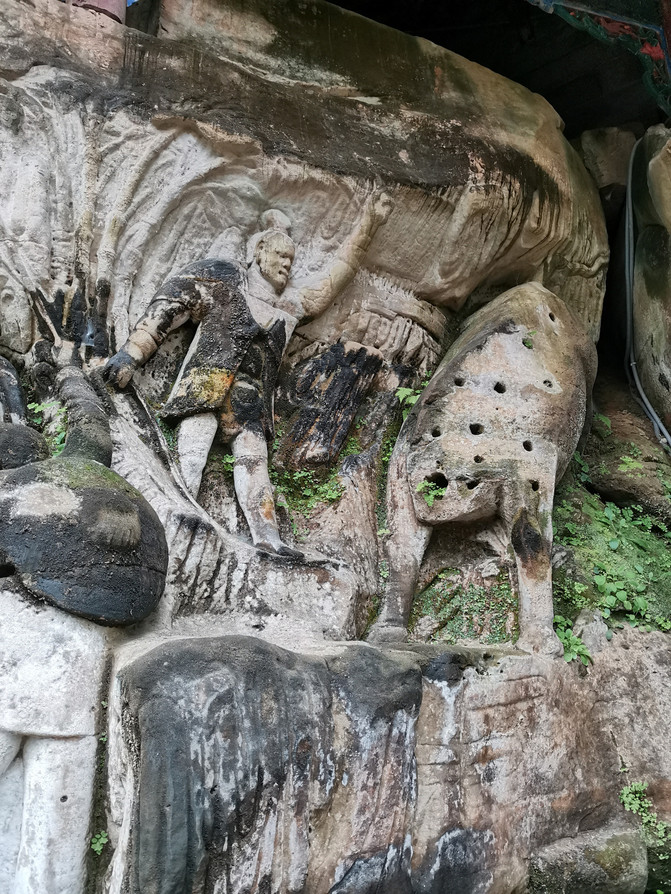



The cattle herding picture is lifelike, and the flute player has a vivid charm.

Arriving at Yuanjue Cave, the stone lion carved at the entrance of the cave is powerful and agile.



Yuanjue Cave is carved out of a whole stone and is as spacious as a room. A skylight is opened above the roof of the cave for lighting, and there are two holes at the entrance. Three Buddha statues are carved on the main wall of the cave. In front of the main Buddha, there is a kneeling Bodhisattva, bowing his head and putting his hands together, respectfully and devout.




There are twelve Yuanjue Bodhisattva on the left and right walls of the cave. They sit on a lotus platform. They are beautiful and solemn, with different postures. Their clothes and muscles are authentic, like tulle protruding bodies, and their dresses are smooth and free. The sculptures between the walls are carved with towers, pavilions, figures, birds and animals, flowers, trees, and secluded springs and strange rocks. They are almost realistic works and are the essence of Dafo Bay carving.

In Yuanjue Cave, when I used my mobile phone to take pictures of a Buddha statue, a magical scene appeared. The Buddha statue was bathed in red light, like the afterglow of the sun shining on the Buddha statue. Is this the manifestation of Buddha's light?




Not far from Yuanjue Cave, the cliff carving ends. There are inscriptions on "Baoding" and stone carvings of Confucianism, Buddhism and Taoism standing side by side.


The ancients said that the Dazu stone carvings "all contained in Buddhist scriptures are listed", while the Baodingshan stone carvings achieve a high degree of unity in art of "the humanization of god and the deification of man".


Exit the Baodingshan exit of Dafo Bay and see an antique two-story Long Live Building with flying eaves and crooked corners.
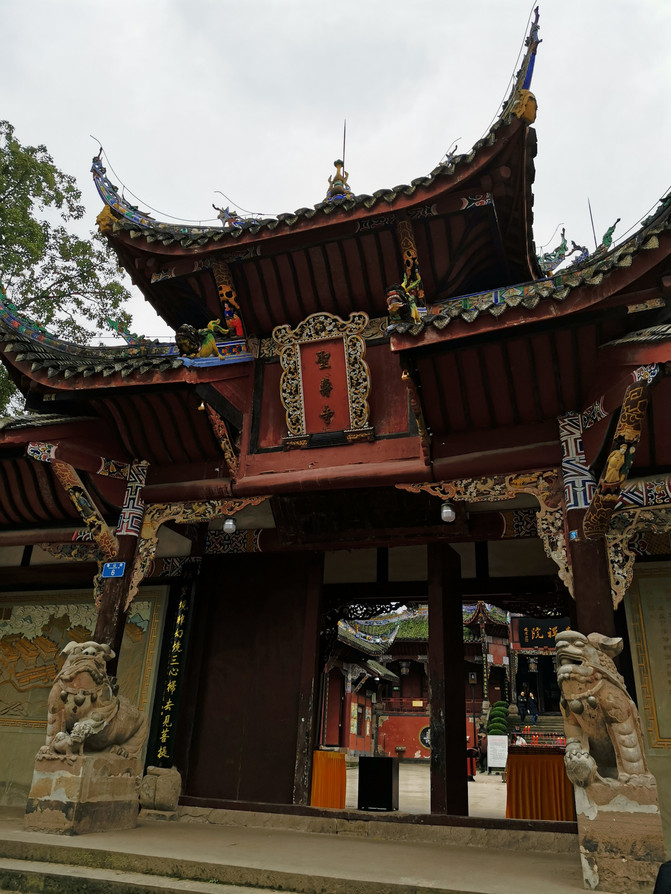
Not far away is Shengshou Temple, an ancient temple built in the Southern Song Dynasty. It has a towering exterior and an ancient environment.
There are cliff stone carvings hidden under the cliff not far from the right side of Shengshou Temple. That should be Xiaofo Bay. I wanted to visit it too, but it was time for the tour group to close up, so I had to give up.
Previous Article:Chongqing Three-Day Food Tour
